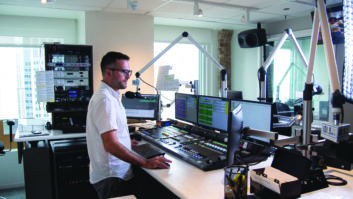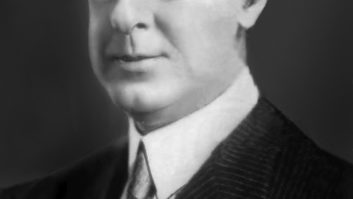(click thumbnail)Mount Wilson at sunset. The tower is KCBS(TV/FM).
(click thumbnail)Art Deco tilework around the front door at KFI.
(click thumbnail)KFI Chief Engineer Tony Dinkel with the base of the tower after the plane crash.
(click thumbnail)KTNQ/KTLK’s towers rise above the industrial park. A screen of wires extends over the parking lot between warehouse buildings and serves as part of the grounding system; it ties into chicken wire that lines the walls and roofs of the buildings.
(click thumbnail)In the RF jungle at Mount Wilson.Interesting broadcast history lurks in less conspicuous corners of LA
From the time I was in middle school, visiting what was then WRTK(AM) at its four-tower directional array next door, no vacation has been complete without at least a few stops at broadcast facilities.
But when Paul McLane invited me to share some of those journeys in a new Radio World column, one destination rose to the top of the pack. Just like Randy Newman sang, “I Love L.A.”
Wired up
At least on the surface, the nation’s second-largest radio market isn’t the place to go if you’re looking for much of a sense of history. Where studios are concerned, Los Angeles doesn’t spend much time looking back.
NBC’s historic West Coast headquarters at Hollywood and Vine? Long gone. KFI’s Art Deco studio plant on Vermont Avenue? A parking lot. Even the Columbia Square facility on Sunset Boulevard, a West Coast hub for CBS since 1938, has a date with the wrecking ball soon; KNX Radio has moved out, as RW reported in the Nov. 23, 2005 issue, and ground has been broken for a new studio for KCBS(TV)/KCAL(TV) as well.
Look beneath the surface, though, and there’s some neat radio history lurking in some less conspicuous corners of the City of Angels.
For instance, the old Odd Fellows Hall on Washington Boulevard, overlooking the Santa Monica Freeway just south of downtown L.A., is, as best I can tell, the oldest AM transmitter site still in use anywhere in the country. KGFJ(AM) went on the air here in 1924, and 82 years later, the station (now KYPA) is still there, using what may be one of the last inverted-L wire antennas in the country. It tried moving a couple of years ago, diplexing with KBLA(AM) up in the hills near Dodger Stadium, but the signal from the old site worked better, and so there it’s stayed.
Or perhaps you’re looking for a five-tower directional array with a warehouse constructed around the tower bases? Head east of downtown to the City of Industry, and gawk your eyes out at the “Towers Industrial Park” on Don Julian Road, just off the Pomona Freeway, where the five sticks of KTNQ(AM) and KTLK(AM) poke up 475 feet above the rooftops of the park’s two huge buildings.
Blame the high price of L.A. real estate for this one: the towers were there first, going up in 1975 as part of a project to turn KTNQ – then George Storer’s KGBS – from a daytimer into a 24-hour operation. The warehouses were built a decade or so later, with Ron Rackley’s talents called upon to design a ground system that included acres of chicken wire lining all the walls and rooftops of the buildings. The towers themselves are still conventional base-insulated towers – but the bases now sit in 25-foot-deep “wells” inside each building, accessible only via a ladder down from the roof.
Just in case that wasn’t complicated enough, Jacor came along in 1997 with an urgent need to boost its KXTA (1150) to 50 kilowatts to meet the terms of a new contract with the Dodgers and only a couple of months to make it happen. In the space of 56 days, the KTNQ site became a diplexed facility, with the KXTA (now KTLK) transmitters in what had been the KTNQ garage and five new ATUs carefully lowered into place (by a “trolley wire” between two cranes) up on the rooftops.
The workers in the industrial park have no idea, for the most part, what those towers overhead – or the wire grid suspended 25 feet above the parking lot between the buildings – is for. In a Los Angeles Times article about the site in 2001, one worker speculated the towers were there to warn airplanes away.
Art Deco
Such a warning device, if only it existed, might have saved another distinctive L.A. tower site from disaster.
I was fortunate to have seen the KFI(AM) site in La Mirada, on the Los Angeles/Orange county line, before a plane crash in December 2004 killed the pilot of a Cessna 182 and his wife and sent the 750-foot tower crashing down. And while it wasn’t until after the tower collapse that I finally got inside the transmitter building, in the company of chief engineer Tony Dinkel, this site, built in 1931, was – and is – remarkable even from the outside.
There’s the transmitter building, with its amazing Art Deco tilework around the front door depicting radio waves emanating from a tower. (Someday I’d love to find duplicates of those for my bathroom.)
Up in the second-floor transmitter room, you can still see the marks on the floor where the original RCA 50B sat for three decades – and the hole in the ceiling where a sniper, stationed at the site to protect it from enemy attack during World War II, accidentally discharged his weapon.
Outside, the orange groves that surrounded the neighborhood in 1931 have given way to warehouses and the hum of busy I-5 a block away. Just as at KTNQ/KTLK, the land here was too valuable to sit empty – in the 1980s, a warehouse complex was built right under the guy wires, and it was a miracle that the area was deserted and the buildings were left almost untouched by the whipping guys when the tower came down that sad Sunday morning.
Someday, with plenty of luck and lots of legal bills, KFI will get the permits it needs to rebuild the big tower. Until then, the station is making do with its short backup tower at 25 kilowatts.
Up on the mountain
There are plenty of other interesting sites I’ve seen over the years in multiple visits to L.A., and plenty more on my list for future trips. It’s a good thing the drive down to L.A. from the NAB convention is relatively short!
We can’t leave southern California without mentioning the one site that keeps bringing me back, visit after visit: the mighty Mount Wilson.
More than a mile above sea level, yet within view of the ocean (when the smog’s not too heavy), the tower farm on Wilson is an hour’s drive, and a world away, from Pasadena and Glendale down below. And in the company of well-connected engineers like Marvin Collins, who was chief of KFI and of KOST(FM) up here for many years, and Burt Weiner, who built several of the sites here and operated the mountain’s first ham repeater, the doors open at many of the transmitter buildings.
After repeated visits, I think I can even pick out which antennas among the forest of RF at the center of the tower farm belong to which stations.
Somehow, it seems as though no matter how early I start up to Mount Wilson, it’s always dusk by the time I’m ready to leave, driving back down the hairpin curves of the Angeles Crest Highway into the sea of lights that stretch out all the way to the Pacific Ocean, far below.

















